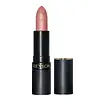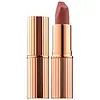Revlon Super Lustrous The Luscious Mattes Lipstick Versus Charlotte Tilbury Matte Revolution Lipstick
What's inside
What's inside
 Key Ingredients
Key Ingredients

 Benefits
Benefits

 Concerns
Concerns

 Ingredients Side-by-side
Ingredients Side-by-side

Diisopropyl Dimer Dilinoleate
EmollientIsononyl Isononanoate
EmollientOzokerite
Emulsion StabilisingAluminum Starch Octenylsuccinate
AbsorbentOctyldodecyl Neopentanoate
EmollientSilica
AbrasiveMica
Cosmetic ColorantNylon-12
Kaolin
AbrasiveSynthetic Wax
AbrasiveCopernicia Cerifera Cera
EmollientMoringa Oleifera Seed Oil
EmollientTheobroma Grandiflorum Seed Butter
Skin ConditioningCaprylic/Capric Triglyceride
MaskingAgave Rigida Extract
Hydrogenated Polyisobutene
EmollientAnemarrhena Asphodeloides Root Extract
Skin ConditioningCera Microcristallina
Emulsion StabilisingEthylene/Propylene Copolymer
AbrasivePolyethylene
AbrasiveBHT
AntioxidantPhenoxyethanol
PreservativeBlue 1 Lake
Cosmetic ColorantIron Oxides
CI 45410
Cosmetic ColorantCI 17200
Cosmetic ColorantCI 15850
Cosmetic ColorantCI 77891
Cosmetic ColorantCI 19140
Cosmetic ColorantDiisopropyl Dimer Dilinoleate, Isononyl Isononanoate, Ozokerite, Aluminum Starch Octenylsuccinate, Octyldodecyl Neopentanoate, Silica, Mica, Nylon-12, Kaolin, Synthetic Wax, Copernicia Cerifera Cera, Moringa Oleifera Seed Oil, Theobroma Grandiflorum Seed Butter, Caprylic/Capric Triglyceride, Agave Rigida Extract, Hydrogenated Polyisobutene, Anemarrhena Asphodeloides Root Extract, Cera Microcristallina, Ethylene/Propylene Copolymer, Polyethylene, BHT, Phenoxyethanol, Blue 1 Lake, Iron Oxides, CI 45410, CI 17200, CI 15850, CI 77891, CI 19140
Neopentyl Glycol Dicaprylate/Dicaprate
EmollientTrimethylolpropane Triisostearate
EmollientDimethicone
EmollientCera Microcristallina
Emulsion StabilisingPolyethylene
AbrasivePolybutene
Dimethicone Crosspolymer
Emulsion StabilisingSilica
AbrasiveDicalcium Phosphate
AbrasiveEthyl Vanillin
MaskingCaprylic/Capric Triglyceride
MaskingTocopherol
AntioxidantCarthamus Tinctorius Seed Oil
MaskingZea Mays Oil
EmulsifyingPentaerythrityl Tetra-Di-T-Butyl Hydroxyhydrocinnamate
AntioxidantCarica Papaya Fruit Extract
Skin ConditioningOrchis Mascula Flower Extract
SoothingBixa Orellana Seed Extract
MaskingBHT
AntioxidantTocopheryl Acetate
AntioxidantTin Oxide
AbrasiveMica
Cosmetic ColorantCI 77891
Cosmetic ColorantIron Oxides
CI 45410
Cosmetic ColorantCI 15850
Cosmetic ColorantCI 42090
Cosmetic ColorantCI 15985
Cosmetic ColorantCI 19140
Cosmetic ColorantCI 75470
Cosmetic ColorantNeopentyl Glycol Dicaprylate/Dicaprate, Trimethylolpropane Triisostearate, Dimethicone, Cera Microcristallina, Polyethylene, Polybutene, Dimethicone Crosspolymer, Silica, Dicalcium Phosphate, Ethyl Vanillin, Caprylic/Capric Triglyceride, Tocopherol, Carthamus Tinctorius Seed Oil, Zea Mays Oil, Pentaerythrityl Tetra-Di-T-Butyl Hydroxyhydrocinnamate, Carica Papaya Fruit Extract, Orchis Mascula Flower Extract, Bixa Orellana Seed Extract, BHT, Tocopheryl Acetate, Tin Oxide, Mica, CI 77891, Iron Oxides, CI 45410, CI 15850, CI 42090, CI 15985, CI 19140, CI 75470
 Reviews
Reviews

Ingredients Explained
These ingredients are found in both products.
Ingredients higher up in an ingredient list are typically present in a larger amount.
BHT is a synthetic antioxidant and preservative.
As an antioxidant, it helps your body fight off free-radicals. Free-radicals are molecules that may damage your skin cells.
As a preservative, it is used to stabilize products and prevent them from degrading. Specifically, BHT prevents degradation from oxidation.
The concerns related to BHT come from oral studies; this ingredient is currently allowed for use by both the FDA and EU.
However, it was recently restricted for use in the UK as of April 2024.
Learn more about BHTThis ingredient is an emollient, solvent, and texture enhancer. It is considered a skin-softener by helping the skin prevent moisture loss.
It helps thicken a product's formula and makes it easier to spread by dissolving clumping compounds.
Caprylic Triglyceride is made by combining glycerin with coconut oil, forming a clear liquid.
While there is an assumption Caprylic Triglyceride can clog pores due to it being derived from coconut oil, there is no research supporting this.
Learn more about Caprylic/Capric TriglycerideCera Microcristallina isn't fungal acne safe.
Ci 15850 is the pigment color red. It is an azo dye and created synthetically.
Azo dyes need to be thoroughly purified before use. This allows them to be more stable and longer-lasting.
This ingredient is common in foundations, lipsticks, and blushes. This color is described as brown/orangey red.
It has many secondary names such as Red 6 and Red 7. According to a manufacturer, Red 6 usually contains aluminum.
Learn more about CI 15850CI 19140 is also known as Tartrazine. Tartrazine is a synthetic dye used in cosmetics, foods, and medicine to add a yellow color.
Tartrazine is created from petroleum and is water-soluble.
Some people may experience allergies from this dye, especially asthmatics and those with an aspirin intolerance.
Learn more about CI 19140CI 45410 is a synthetic red-pigment and dye.
It often goes by both Red 28 or Red 27; manufacturers label both ingredients as CI 45410.
This dye is commonly found in makeup because it imparts a vivid color. Some types of this dye change color based on pH level and interaction with moisture:
Your skin has a natural pH of around 4.5 - 5.5.
According to the FDA, CI 45410 is not permitted for use in eye products.
Red 27 is a flourescein dye and commonly used as a fluorescent tracer in medicine.
Learn more about CI 45410Ci 77891 is a white pigment from Titanium dioxide. It is naturally found in minerals such as rutile and ilmenite.
It's main function is to add a white color to cosmetics. It can also be mixed with other colors to create different shades.
Ci 77891 is commonly found in sunscreens due to its ability to block UV rays.
Learn more about CI 77891Mica is a naturally occurring mineral used to add shimmer and color in cosmetics. It can also help improve the texture of a product or give it an opaque, white/silver color.
Serecite is the name for very fine but ragged grains of mica.
This ingredient is often coated with metal oxides like titanium dioxide. Trace amounts of heavy metals may be found in mica, but these metals are not harmful in our personal products.
Mica has been used since prehistoric times throughout the world. Ancient Egyptian, Indian, Greek, Roman, Aztec, and Chinese civilizations have used mica.
Learn more about MicaPolyethylene is a synthetic ingredient that helps the skin retain moisture. It is a polymer.
It is also typically used within product formulations to help bind solid ingredients together and thicken oil-based ingredients. When added to balms and emulsions, it helps increase the melting point temperature.
Silica, also known as silicon dioxide, is a naturally occurring mineral. It is used as a fine, spherical, and porous powder in cosmetics.
Though it has exfoliant properties, the function of silica varies depending on the product.
The unique structure of silica enhances the spreadability and adds smoothness, making it a great texture enhancer.
It is also used as an active carrier, emulsifier, and mattifier due to its ability to absorb excess oil.
In some products, tiny microneedles called spicules are made from silica or hydrolyzed sponge. When you rub them in, they lightly polish away dead skin layers and enhance the penetration of active ingredients.
Learn more about SilicaThis ingredient is a combination of red, black, and yellow iron oxide pigments. This combination of colors is usually found in foundation, because it results in a "skin" color.